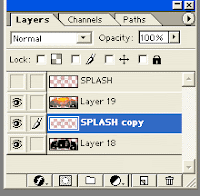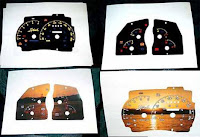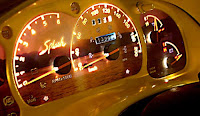'Angel Eye' is a cool headlight feature found on the new (2001+) BMW 5 Series. The projector headlamp unit on the BMW 5 series has a pair of circular-shape rings that when light up, they produce a pair of halos. BMW calls them 'Angel Eyes'. Creating Angel Eye Rings
Creating Angel Eye Rings
Instead of a round glass rod used by BMW, I used a clear acrylic/plastic rod.The rod is actually made for your window blind to open/close the blind when you turn it left/right.It is about 50 cm long with a diameter of 8mm, and you can create 2 angel rings out of it. The rod has a hex-shape structure, not a round shape like the BMW, but it will do just fine because this reflects more light.



he first thing I did was to create a circular ring out of it. I measured the diameter of my high-beam projector housing, which comes out to be 4" (or 2" radius). Usingthe circular formula (C=2'pi'r, where pi=3.14), you'll have to cut your rod about 12.5 inches long. I suggest cutting it 15" long, and use the extra inches as handles to help in the molding process.
Next, I find an aluminum can or jar that has about the same diameter as the ring (I used a peanut jar). After heating the rod in a small toaster oven for about 5-7 minutes at 300°F, I held the two ends of the now flexible rod with a pair of pliers, and wrapped them around the peanut jar with one end crossing over the other end.
For better control, you can wear your winter gloves or use your socks. The flexible rod will harden within a minute. So, you may have to repeat this step 1 more time to mold it into a perfect circular ring.
Once done, you can use a Dremel tool to cut the extra handles that were used during the molding process. You will end up with one end above the other, as shown.
Don't worry; later when you wrap electrical tape around the rod to hide the LED bulbs, the two open ends will realign themselves. If you like to be perfect, you can simply put it back in the oven one last time and allow the ends to soften and flatten.
Making The Eagle Ring Light Up
In order to make it lights up like the true 'Angel Eye', I had to refract the light as it goes through the rod by making multiple cuts (scratches) along the rod, using a Dremel tool. Each cut/groove allows the light to 'escape' the ring. Each cut is about 2~3mm apart. Don't make the cuts too close to one another. This will make your ring look like a continuous band of light, like those glow-in-dark flexible toys. In my opinion, the ring look better and more sophisticated with the cuts evenly space out.
It will take about 2 minute to do the cuts using a Dremel tool. If you don't have a Dremel tool, you can use a small saw or a butter knife, but will take you longer. A Dremel tool set would cost about $30. It has many uses, such as cutting, sanding, carving, buffing, etc. Good tool to have for hobbies.
Hint: To get the cuts look perfect, you can do the cuts ahead of time before making a circular ring out of it. You only need to make the cuts along 1 of the 6-sided rod.
Doing 2 or more sides will make your ring look dimmer, because most of it has 'escaped' before it reaches the other end of the rod. Also, let the cut side be the backside. When you turn it over to the front, the hex shape, which acts like mirrors, will multiply the cuts and the cuts are brighter too. The light appears to be refracted inward (take a look at the pictures below on the right to see what I mean).

 With a Dremal tool, you can
With a Dremal tool, you can
create the cuts in 2 minutes. LED Light For ANGEL EYES
LED bulbs are very efficient, last very long (no filament to burn out), and produce very little heat. The LED bulb along with the resistor use less than 1W of power, compare to a 35W halogen bulb used in the real BMW angel eyes. LED bulbs are bright too even though they are only 1 mcd.

Angel Eye with blue LED.
They cost from around $3 to $4 each at your local Radio Shack store. Note that LED bulbs are not like halogen bulbs where you can just connect positive and negative wires to them to light them up. You must use a resistor. The purpose of the resistor is to limit/resist high current going through the LED bulbs. LED bulbs require only a small amount of current to light up. Hence they are very efficient. Resistors should cost about $1 for a set of 5 at a local store like Radio Shack. Very cheap!
Resistance is measured in ohms. To get the correct resistor for your LED, use this modified version of Ohm's Law:
Ohms = ( V.bat - V.led ) / Amp.led. where V.bat = voltage of battery, V.led = voltage of LED, Amp.led = Amp of LED
When you buy the LED bulb, it will tell you the voltage and amp used. Just plug them into the equation to get the Ohms value. In my case, I have a 12V battery and a 3.6V LED with 20mA (or .02A). So, I used a resistor of 420 ohms [(12V - 3.6V)/.02A]
You can use a lower ohms resistor, eg 220 ohms, to light up your LED. In fact, it will make your LED brighter because low resistance allows more current to go through the bulb. I have been doing this for 3 months now and still haven’t had any problems.
Also, you must attach the resistor to the positive terminal of LED bulb, which is the longer of the 2 terminal legs. I suggest that you attach a wire to the LED bulb first, and then attached a resistor at the end of the wire on the positive terminal. This will give you flexibility because the resistor will be outside your headlight unit and you can change it if you have a need to do so later, like changing to a lower resistor to make your Angel Eye brighter.
Resistor connected to positive lead,
which is the longer one.
Securing LED Bulbs Inside ANGEL EYE RingsTo secure the LED bulbs into my Eagle Eye rings, I drilled a hole in both ends of the ring, about 6mm wide and 5mm deep. I used two white LED bulbs and parallel
paired them together. After soldering a foot-long wires to the positive and negative legs of the LED bulbs, I wrapped black electrical tape around the legs to keep them
apart. I will attach the resistor to the end of the wire later when I connect the wire to my parking light.
Next, I inserted the bulbs inside the holes of the ring, and wrapped black electric tape around it to hide to LED bulbs. This will also hold the bulbs and the two ends of
the rod in place. DO NOT paint the rod black. For some reason, the black paint will absorb the light and will make your angel ring look dim. If you plan to wrap the black
tape around the uncut/unused part of the ring, make sure you wrap some aluminum foil around them first before wrapping the black tape. The aluminum foil will reflect.

LED bulbs inside ring.
Taking Apart Projector Headlight
Next, it was time for me to put them into my HID projector headlight unit. First, I had to open apart my headlight unit. This is done by heating it in a cooking oven for about 10-15 minutes at 275°F or until the glue loosens. It may take a longer or shorter time to soften the glue on different headlamp units. Remove any attachments, like your bulb or wire harness, that may not be able to withstand the heat. Be very careful when separating your projector unit because the glue will stick to anything it can get a hold of. Think of hot melted cheese on a slice of pizza when you pull it apart.
My aftermarket projector headlight is divided into 3 components, a reflective housing, an internal black frame, and a clear front cover. I glued my angel rings to the black frame, using clear silicon adhesive or Crazy/Super glue. I applied only a very small amount of glue to the un-scratch/un-cut part of the ring. The inner black frame acts as a barrier and helps protect my angel eyes from the heat coming from the reflective housing.
Putting the Headlight Back Togetherext, it was time for me to re-attach the front cover back onto the headlight unit, using the same glue. Just reheat them in the oven until the glue softens again. Very important, I only had to heat the reflective housing and the front cover. You don't need to reheat the black internal frame. Plus, the angel rings on your black frame may deform.
Once the glue is softening again, I took out the reflective housing and the clear front cover. I put the black frame with the angel rings back onto the reflective housing.
Then I ran the wire from the angel ring through the water drainage opening of the housing. Now, I put the clear front cover back onto the headlight housing. Remember to apply pressure to get an airtight hold. I had to sit on it to get this done. I also used clamps to make a tight seal. Finally, I put the headlight unit back onto my car. With a 220 ohms resistor attached to the positive terminal of the LED wire, I made a parallel connection to my parking lights. You can connect it to anything, an external light switch, high beam, running light, etc.
by: RobinHooD



























